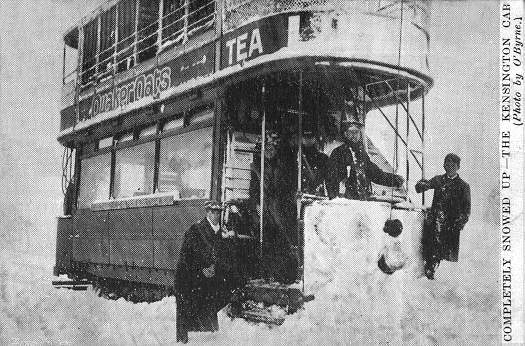

With place names such as Kensington, Sydenham, Norwood, Belgravia, Brixton and Mayfair you might be forgiven for thinking that we are in London, but in fact this is Johannesburg in the Transvaal, South Africa. Our seasonal postcard entitled "Completely Snowed Up - The Kensington Car", is from an unknown printer but the caption tells us "Photo by O'Byrne". The hand written message on the back reads "This snow storm occurred on Monday and Tuesday 18th & 19th August 1909 and was unparalleled in Transvaal history - 2 feet of snow." [Note: August is mid-winter in the southern hemisphere]
Trams in Johannesburg began on 2nd February 1891 with horse cars of 3ft 6in gauge run by the City and Suburban Tramway Company. This was taken over by the local council and under the name of Johannesburg Municipal Tramways, the lines were converted to standard gauge with electric car services starting on 14th February 1906.
The single track route to the Kensington township in the eastern suburbs began on 16th February 1907 although after a few months the last half mile closed due to lack of passengers and was not reopened for the next five years. In early days cars operated from Kensington to the city centre and then ran via Eloff Street and onto the route to Parktown in the north. From 1925 all routes terminated in the city centre and after 1936 the Kensington tram became route "F". At its peak the Johannesburg system operated 242 trams on a dozen routes.
The four-wheel car in the picture is one of the initial order of 100 trams built by the Electric Railway and Tramway Carriage Works (from late in 1905 renamed the United Electric Car Company) at Preston, England between 1905 and 1907. They were shipped to Johannesburg in parts and assembled there. Each car had two Dick Kerr 35 horsepower motors, Dick Kerr DB1 form B controllers and was mounted on a Brill 21E, 6ft 6in wheelbase four-wheel truck. They had a variety of longitudinal and transverse seating arrangements and three or five lower deck windows. Twenty cars were supplied as open-top.
As built twenty cars of this series were open top and twenty had five windows on the lower deck instead of three. The upper deck sides were open and there were red and white striped roller blinds which could be drawn down to protect passengers from the weather. Soon the open cars were fitted with top covers. Many cars in the series were rebuilt from three window to five window, and normal drop windows were fitted to the open sides on the upper deck. Nine cars were cut down to single deckers.
The original livery for the first forty cars was light brown and cream, but this was soon changed for all trams to deep chocolate and cream. New bogie cars built in the 20s were painted navy blue and dove grey. From 1934 the colours became cherry red and cream.
At first power was generated by eight gas engine sets but these were a failure and were replaced in June 1907 by steam engines. As a result, legal action was taken against the electrical suppliers D. Stewart and Co. and the engine builder Joseph Beardmore both of Glasgow.
In 1934 a commission headed by C.J.Spencer of London Transport (former manager of the London "company" tramways) reviewed the tramway after which fifty Metropolitan Cammell bogie trams were provided and tracks including the Kensington route were doubled with some extensions. Other routes were converted to buses, and trolleybuses were introduced to the city on the bus route to Norwood. The trolleybuses were a great success and the anti-tram newspapers called for more conversions. These began but were halted by the Second World War during which 18 AEC trolleybuses built for Johannesburg (together with 35 Leylands for Durban) were famously diverted by the British Government to London Transport and which as class SA3 ran in the Ilford area until 1959. see photo
After the war tramway conversion continued with a maximum of 165 trolleybuses being operated. The last tramcar ran on 18th March 1961. A number of Johannesburg trams were preserved and of the four-wheelers car number 20 (with other types) was kept in Johannesburg at the James Hall Museum of Transport and car number 60 is at the National Tramway Museum at Crich in England. The last of Johannesburg's nineteen trolleybus routes closed on 28th November 1986.
![]() Go to Postcard Of The Month Index
Go to Postcard Of The Month Index